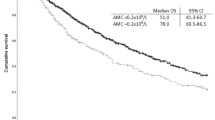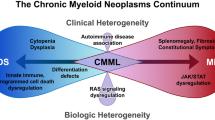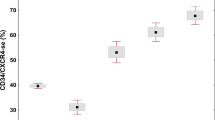Abstract
Ninety-seven cases of chronic myelomonocytic leukaemia (CMML) were examined retrospectively for survival and possible prognostic factors including age, total white cell count, peripheral blood and bone marrow monocyte counts, % double esterase (DE) positive cells in bone marrow and serum lysozyme. Age, absolute monocyte counts and serum lysozyme proved to be significant independent prognostic indicators but Cox model analyses showed serum lysozyme to be the most important factor whether taken as a continuous or discrete (two groups) variable. Twelve cases of second malignancy were found, including 2 cases of multiple myeloma, but this was not significantly greater than expected when compared with an age and sex matched group.
This is a preview of subscription content, access via your institution
Access options
Subscribe to this journal
Receive 24 print issues and online access
$259.00 per year
only $10.79 per issue
Buy this article
- Purchase on Springer Link
- Instant access to full article PDF
Prices may be subject to local taxes which are calculated during checkout
Similar content being viewed by others
Rights and permissions
About this article
Cite this article
Stark, A., Thorogood, J., Head, C. et al. Prognostic factors and survival in chronic myelomonocytic leukaemia (CMML). Br J Cancer 56, 59–63 (1987). https://doi.org/10.1038/bjc.1987.154
Issue Date:
DOI: https://doi.org/10.1038/bjc.1987.154
This article is cited by
-
Models of Prognostication in Chronic Myelomonocytic Leukemia
Current Hematologic Malignancy Reports (2017)
-
Klinik, Morphologie und Prognose chronischer myelomonozytärer Leukämien
Medizinische Klinik (1999)



